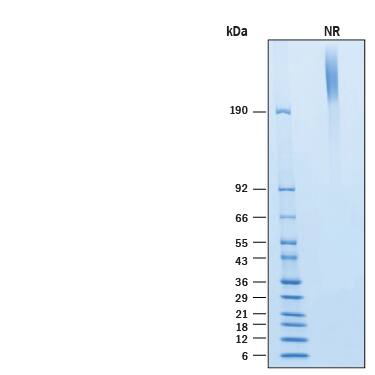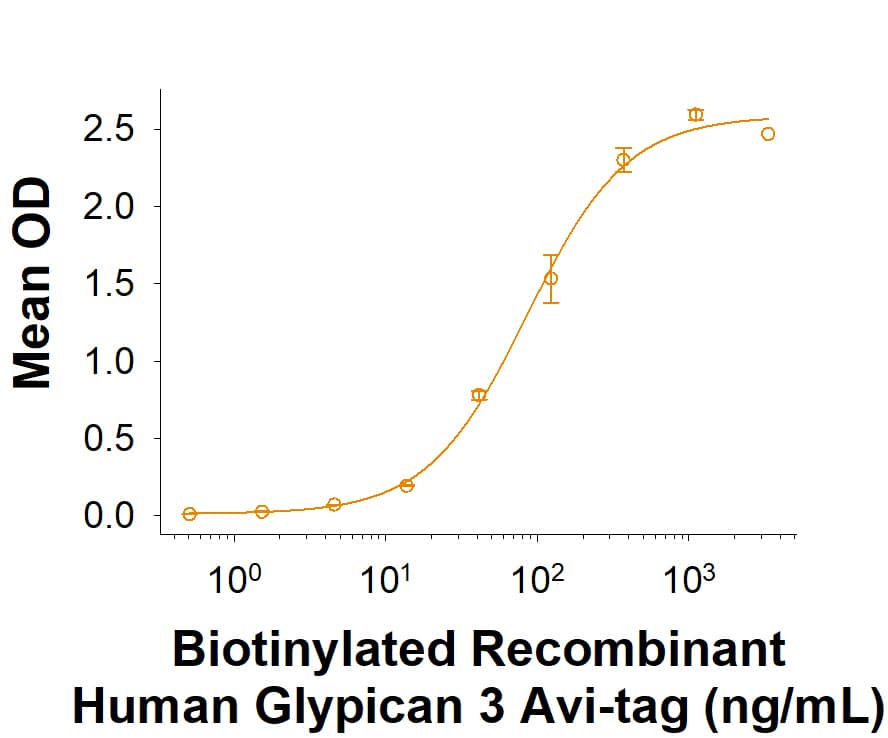Recombinant Human Glypican 3 Fc Chimera Avi-tag Protein, CF
R&D Systems, part of Bio-Techne | Catalog # AVI11078

Key Product Details
- R&D Systems CHO-derived Recombinant Human Glypican 3 Fc Chimera Avi-tag Protein (AVI11078)
- Quality control testing to verify active proteins with lot specific assays by in-house scientists
- All R&D Systems proteins are covered with a 100% guarantee
Source
CHO
Structure / Form
Disulfide linked homodimer
Biotinylated via Avi-tag
Biotinylated via Avi-tag
Conjugate
Biotin
Applications
Bioactivity
Product Specifications
Source
Chinese Hamster Ovary cell line, CHO-derived human Glypican 3 protein
| Human Glypican-3 (Gln25-His559) Accession # P51654.1 |
IEGRMD | Human IgG1 (Pro100-Lys330) |
Avi-tag |
| N-terminus | C-terminus | ||
Purity
>90%, by SDS-PAGE visualized with Silver Staining and quantitative densitometry by Coomassie® Blue Staining.
Endotoxin Level
<0.10 EU per 1 μg of the protein by the LAL method.
N-terminal Sequence Analysis
Gln25
Predicted Molecular Mass
89 kDa
SDS-PAGE
>190 kDa, under non-reducing conditions.
Activity
Measured by its binding ability in a functional ELISA.
Biotinylated Recombinant Human Glypican 3 Fc Chimera Avi-tag (Catalog # AVI11078) binds to Recombinant Human FGF basic/FGF2/bFGF (Catalog # 233-FB/CF) with an ED50 of 60.0-720 ng/mL.
Biotinylated Recombinant Human Glypican 3 Fc Chimera Avi-tag (Catalog # AVI11078) binds to Recombinant Human FGF basic/FGF2/bFGF (Catalog # 233-FB/CF) with an ED50 of 60.0-720 ng/mL.
Scientific Data Images for Recombinant Human Glypican 3 Fc Chimera Avi-tag Protein, CF
Biotinylated Recombinant Human Glypican 3 Fc Chimera Avi-tag Protein Binding Activity.
In a functional ELISA, Biotinylated Recombinant Human Glypican 3 Fc Chimera Avi-tag Protein (Catalog # AVI11078) binds to Recombinant Human FGF basic/FGF2/bFGF (233-FB/CF) with an ED50 of 60.0-720 ng/mL.Biotinylated Recombinant Human Glypican 3 Fc Chimera Avi-tag Protein SDS-PAGE.
2 μg/lane of Biotinylated Recombinant Human Glypican 3 Fc Chimera Avi-tag Protein (Catalog # AVI11078) was resolved with SDS-PAGE under non-reducing (NR) condition and visualized by Coomassie® Blue staining, showing bands at >190 kDa.Formulation, Preparation and Storage
AVI11078
| Formulation | Lyophilized from a 0.2 μm filtered solution in PBS with Trehalose. |
| Reconstitution | Reconstitute at 250 μg/mL in water. |
| Shipping | The product is shipped at ambient temperature. Upon receipt, store it immediately at the temperature recommended below. |
| Stability & Storage | Use a manual defrost freezer and avoid repeated freeze-thaw cycles.
|
Background: Glypican 3
References
- Ho, M. and Kim, H. (2012) Eur. J. Cancer. 47:333.
- Haruyama, Y. and Kataoka, H. (2016) World J. Gastroenterol. 22:275.
- Shimizu, Y. et al. (2019) Front Oncol. 9:248.
- Gonzales, A.D. et al. (1998) J. Cell Biol. 141:1407.
- Xue, Y. et al. (2018) Am J Pathol. 188(6):1469.
- Ge, S. et al. (2018) Filmus, Int J Clin Exp Pathol. 11(12):5774.
- Pilia, G. et al. (1996) Nature Genet.12:241.
Alternate Names
GPC3
Gene Symbol
GPC3
Additional Glypican 3 Products
Product Documents for Recombinant Human Glypican 3 Fc Chimera Avi-tag Protein, CF
Product Specific Notices for Recombinant Human Glypican 3 Fc Chimera Avi-tag Protein, CF
For research use only
